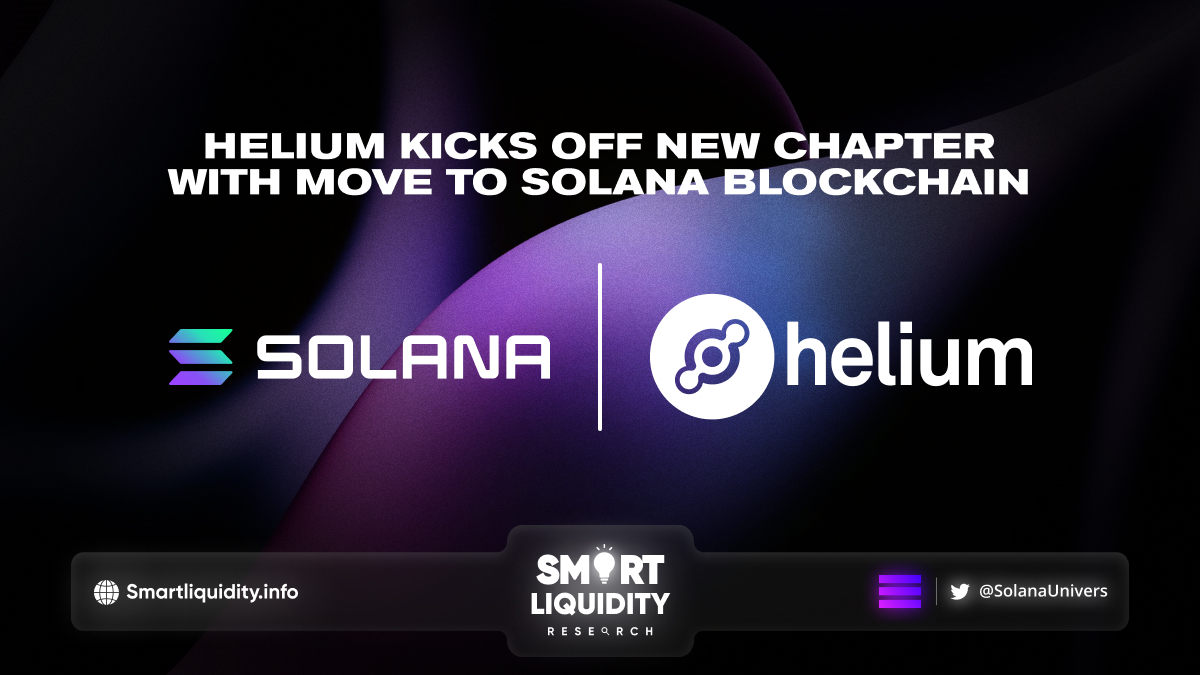Helium Successfully Migrated to Solana


Following more than a year of preparation and work, Helium has successfully migrated to Solana, marking the start of a fresh chapter in decentralized wireless networks that prioritizes scalability and reliability.
After over a year of planning and development, Helium has successfully migrated to Solana, ushering in a new phase of reliability and scalability for decentralized wireless networks.
The migration of the Helium Network to Solana brings substantial improvements to the network. Such as increased transaction speeds and access to new smart contract features. Moreover, the shift frees up core developers from the maintenance of a layer-1 blockchain. This means that the Helium Foundation and other organizations involved can now allocate more resources towards their common objectives of promoting the growth of decentralized wireless networks, creating applications that drive economic efficiency, and bridging the digital divide.
Helium Overview
The Helium Network was launched in 2019 with the mission of delivering a decentralized, open-source, accessible, and secure wireless network for the entire world. The foundation of the network was its own blockchain to incentivize the usage and expansion of a community-built wireless network.
- Helium is now the largest LoRaWAN network in the world, with almost one million Hotspots deployed since launch and coverage in more than 77,000 towns and cities in 192 countries.
- The following metro areas are just some of the cities with complete coverage: Lisbon, Los Angeles, New York City, Washington DC, London, Zurich, Amsterdam, Istanbul, Berlin, and Sydney, among many others.
- The Helium 5G network is also experiencing rapid growth, and the community has deployed more than 8,000 5G radios in less than a year.
- There are currently 25+ approved Hotspot manufacturers, four major LoRaWAN roaming partners, and a partnership with a nationally recognized carrier for 5G coverage.
- Approximately 100,000 devices are actively using the Helium Network for connectivity, not including access through roaming partners.
The Vote to Move to Solana
However, to maintain scaling capabilities, the Helium community made an active decision last year that a new architecture for its L1 blockchain would be necessary. Core developers were spending an inordinate amount of time maintaining the Helium blockchain as two foundational elements of the network — proof of coverage and reliable data transfer activity — were becoming challenging for the blockchain to handle.
The Helium community determined and successfully voted on a proposal to upgrade the network by migrating to the Solana blockchain, to solve these challenges and set up Helium for long-term success. Two weeks ago, the core working group recommended that the upgrade should proceed after months of preparation, and they are delighted to report that the transition has been completed successfully.
The upgrade will implement several technical changes to Helium that will benefit network users and the community:
- Smart Contract Platform: Adding smart contract functionality to the Helium Network unleashes massive potential for more programmatic features and tools.
- New Feature Possibilities: It’s economically inefficient to price data transfer in New York City the same as in rural Indonesia, where there’s far less Hotspot concentration. Thanks to increased functionality on Solana, the Helium Network can introduce dynamic markets to allocate rewards better based on regional demand.
- Lower Costs: Forget $0.35 transaction fees on the Helium Blockchain. On Solana, the average transaction fee is $0.00025.
- Access to DeFi: Solana boasts a highly liquid and diverse DeFi ecosystem. Owners of HNT, IOT, or MOBILE tokens can access more markets and provide liquidity in exchange for rewards on platforms such as Orca or Kamino. The open-source Helium Wallet app will also feature direct access to DeFi.
- Larger, Global Developer Community: Helium’s layer-1 blockchain was written in Erlang, which is far less common in crypto communities. Solana boasts a highly engaged, global developer community, with Hacker Houses hosted monthly worldwide.
- Network Efficiency: Functions of the network have been moved to oracles. Not only does this mean faster data processing for devices, but also that users will not need to rely on chain uptime for data throughput; more stability and more reliability overall.
- SPL Compatibility: By migrating HNT to the Solana Program Library (SPL) standard, it carries the opportunity of making HNT natively compatible with other platforms within Solana’s ecosystem as well as streamlining integrations across the entire crypto industry where SPL is a commonly accepted standard for exchanges, wallets, and service providers, adding even more utility for HNT, MOBILE, and IOT token owners.
- HNT: The current native token, HNT, will no longer be mined by LoRaWAN Hotspots, which will instead mine IOT, which serves as both the incentive and governance token for the Helium IoT Network. HNT will remain the exclusive token to use the Network; HNT will still be burned for Data Credits (DCs). Both the IoT and 5G sub-networks will be priced through distinct, independent governance.
- Changes to Vote and Governance: The Helium governance model will pivot away from purely HNT-weighted voting to a weighted model of voting that benefits long-term aligned partners through a vote-escrow system. Not only does this shift power to those taking a long view of Network health, but it also delivers yield for delegating native Helium tokens. It also enables independent governance for the IoT and 5G networks.
- Open Source Development: The Solana migration will also allow developers to use the Helium core technology to build new technologies. Helium will become a base layer for projects and businesses to build on top of whenever they are in need of wireless connectivity.
— Over 100,000 devices use the Helium Network for connectivity today.
— Example applications include physical asset tracking, air quality monitoring, water metering, wildfire detection, foot traffic monitoring, and more.
— The Helium Foundation has recently reopened its grant program to facilitate and fund open-source development for hardware and software benefitting decentralized wireless and applications running on the network.
Helium Network Objective
Helium’s fundamental objective is to provide a decentralized wireless network that spans the globe and reaches every individual and device. This objective was impossible to achieve without the improvements in scalability and reliability brought about by this upgrade. Network users can look forward to faster transaction speeds and more comprehensive network capabilities. Now, core developers can focus on improving network features with more resources and advanced blockchain technology available through the Solana ecosystem.
About Helium
Powered by the Solana Blockchain, The People’s Network represents a paradigm shift for decentralized wireless infrastructure.
SOURCE
https://blog.helium.com/a-new-era-for-helium-begins-with-upgrade-to-solana-blockchain-88b742276ec1




